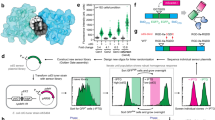Abstract
CHEMOTAXIS is the process by which bacteria travel to higher concentrations of attractant or lower concentrations of repellant. Its study has attracted wide interest as an example of the stimulus-response network since bacteria are the most primitive of living creatures. Behaviour in peritrichous bacteria is indeed simple: bacteria alternately swim smoothly and tumble, which results in random reorientation for the next swim1. Chemotaxis occurs by the increasing tendency of bacteria to tumble when headed in the ‘unfavourable’ direction and by increasing inclination to swim when the bacteria are headed in the ‘favourable’ direction (such as towards higher attractant concentrations)1,2. Tumbling is caused by clockwise rotation of flagella and swimming by counter-clockwise rotation3. Addition of repellent to bacteria causes tumbling; addition of attractant causes swimming4–6. Understanding how the switch that controls direction of flagellar rotation is controlled and how the controlling parameter is regulated by changes in attractant or repellent concentration is necessary to understand chemotaxis. Here I present evidence that for Bacillus subtilis the free concentration of internal Ca2+ ion controls direction of flagellar rotation (high concentrations bringing about tumbling; low concentrations, swimming) and that repellents, which cause tumbling when added to bacteria, work by increasing the flow of Ca2+ ion across the plasma membrane.
This is a preview of subscription content, access via your institution
Access options
Subscribe to this journal
Receive 51 print issues and online access
$199.00 per year
only $3.90 per issue
Buy this article
- Purchase on Springer Link
- Instant access to full article PDF
Prices may be subject to local taxes which are calculated during checkout
Similar content being viewed by others
References
Berg, H. C. & Brown, D. A. Nature 239, 500–4 (1972).
Macnab, R. M. & Koshland, D. E. Jr Proc. natn. Acad. Sci. U.S.A. 69, 2509–12 (1972).
Larsen, S. H., Reader, R. W., Kort, E. N., Tso, W.-W. & Adler, J. Nature 249, 74–7 (1974).
Tsang, N., Macnab, R. & Koshland, D. E. Jr Science 181, 60–3 (1973).
Ordal, G. W. & Goldman, D. J. Science 189, 802–5 (1975).
Ordal, G. W. & Goldman, D. J. J. molec. Biol. 100, 102–5 (1976).
Reed, P. W. & Lardy, H. A. J. biol. Chem. 247, 6970–7 (1972).
Rosen, B. P. & McClees, J. Proc. natn. Acad. Sci. U.S.A. 71, 5042–6 (1974).
Portzehl, H., Caldwell, P. C. & Ruegg, J. C. Biochim. biophys. Acta 79, 581–91 (1964).
Ordal, G. W. J. Bact. 126, 706–11 (1976).
Ordal, G. W. & Gibson, K. J. J. Bacter. 129, 151–5 (1977).
Ordal, G. W. J. theor. Biol. (in the press).
Silver, S. Bacterial Transport (Dekker, New York, in the press).
Eckert, R. Science 176, 473–81 (1972).
Naitoh, Y. & Eckert, R. Science 164, 963–5 (1969).
Naitoh, Y. & Kaneko, H. Science 176, 523–4 (1972).
Hagins, W. & Yoshikami, S. Expl Eye Res. 18, 299–306 (1974).
Van Winkle, W. B. & Schartz, A. A. Rev. Physiol. 38, 247–72 (1976).
Gerich, J. E., Charles, M. A. & Grodsky, G. M. A. Rev. Physiol. 38, 353–88 (1976).
Assimacoupoulos-Jeannet, F. D., Blackmore, P. F. & Exton, J. H. J. biol. Chem. 252, 2662–9 (1977).
Dawson, R. M. C., Elliott, D. C., Elliott, W. H. & Jones, K. M. Data for Biochemical Research (Clarendon, Oxford, 1969).
Author information
Authors and Affiliations
Rights and permissions
About this article
Cite this article
ORDAL, G. Calcium ion regulates chemotactic behaviour in bacteria. Nature 270, 66–67 (1977). https://doi.org/10.1038/270066a0
Received:
Accepted:
Issue Date:
DOI: https://doi.org/10.1038/270066a0
This article is cited by
-
Evolution of mechanisms of Ca2+-signaling: Role of calcium ions in signal transduction in prokaryotes
Journal of Evolutionary Biochemistry and Physiology (2005)
-
The calcium requirement for functional vesicle development and nitrogen fixation by Frankia strains EAN1pec and CpI1
Archives of Microbiology (1987)
-
The role of calcium in stalk development and in phosphate acquisition in Caulobacter crescentus
Archives of Microbiology (1984)
-
Nutrient chemotactic agents and the in vitro selective control of bacterial colonization
Infection (1984)
Comments
By submitting a comment you agree to abide by our Terms and Community Guidelines. If you find something abusive or that does not comply with our terms or guidelines please flag it as inappropriate.



